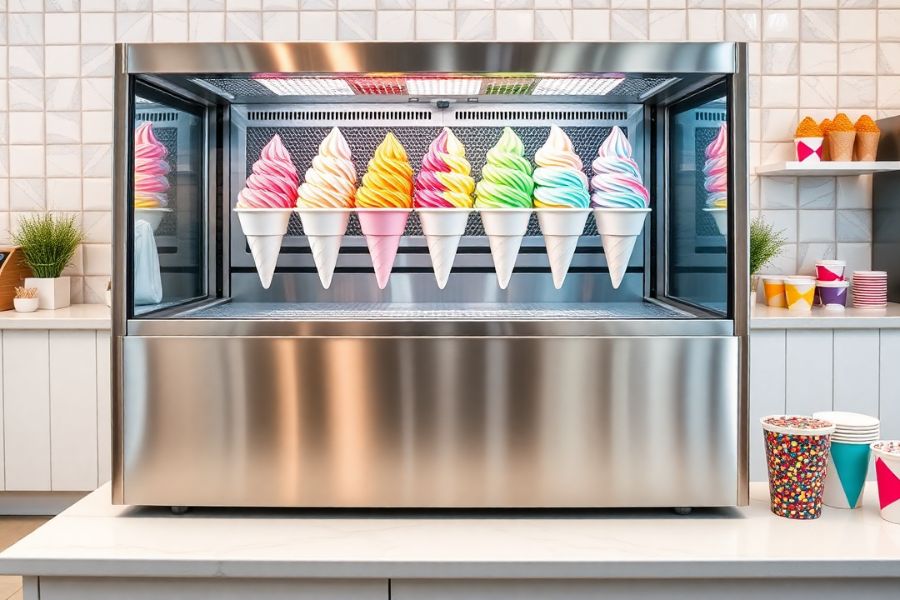Soft serve freezers are an essential piece of equipment for ice cream shops, restaurants, and other establishments that serve soft serve desserts. These machines offer a consistent, creamy, and smooth product that customers love. However, just like any other mechanical equipment, soft-serve freezers require regular maintenance to ensure optimal performance and longevity. When properly cared for, your Taylor C713 soft serve freezer will provide consistently high-quality ice cream, improve customer satisfaction, and help reduce costly repairs or breakdowns. Below are some essential tips to maintain your soft serve freezer for better performance.
1. Regular Cleaning
Regular cleaning stands as one of the essential factors for sustaining your soft serve freezer operation. The high frequency of operation leads soft serve machines to encounter significant exposure of ice cream mix that produces residue accumulation. Overtime the accumulated residue damages both performance quality and leads to flavored compromise as well as texture deterioration and contamination of the ice cream. Maintaining regular cleaning procedures frees the machine parts from ice cream residue and bacterial presence necessary to preserve product quality and ensure food safety.
Soft serve freezers need cleaning either right after each usage or a minimum of once every day based on machine utilisation levels. The ice cream mix handling parts, including the mix hopper, auger, dispensing nozzle and air mix tubes, should always be cleaned properly. Soft-serve freezer manufacturers produce step-by-step cleaning directions which customers need to follow to protect their equipment from getting damaged. A few machines include automated cleaning routines which users can initiate through the machine controls to facilitate the maintenance procedures.
Cleaning your machine both protects your facility from germs and maintains the consistent texture and creamy quality of your frozen dessert products. A machine which has accumulated dirt can produce multiple problems including texture irregularity together with reduced freezing capabilities and sometimes necessitate expensive replacement of damaged components.
2. Proper Storage of Ice Cream Mix
The quality of the ice cream mix used for soft-serve operations is of equal importance to that of the complementary soft-serve freezer system. The correct storage of ice cream mix serves as essential for preserving product taste and consistency. The ice cream mix requires storage at its recommended temperature since bad storage leads to spoiled mix which degrades the quality of your soft serve.
Ice cream mix needs proper storage in refrigerator conditions that should maintain between 34°F to 38°F. The temperature range enables mix freshness by promoting it to stay edible until being utilised. Leaving your mix exposed to room temperature along with maintaining very high storage temperatures will make your ice cream spoilt and its quality suffer. Practising regular checks on your ice cream mix expiration dates allows you to maintain the usage of fresh ingredients.
Proper equipment requires a specific blend type for operation. Soft serve freezers operate with two different mix setups where some need pre-mixed ice cream but others need air combination with liquid. Select your mix according to your machine model and pay attention to correct storage and handling rules for these products.
3. Sanitise Components Regularly
Sanitising techniques should be performed on all soft serve freezer components that make contact with ice cream mix during the dispensing process. Air mix tubes along with dispenser heads and nozzles need frequent sanitisation because they easily accumulate bacteria when proper sanitation measures are not used.
Given that sanitation exceeds mere cleaning, it requires the application of authorised sanitising products to eliminate dangerous microorganisms and bacteria. The market offers food equipment-specific sanitising products, but ice cream contact components also work with bleach-water mixtures to achieve sanitisation. The machine needs thorough rinsing of all parts before assembly to eliminate any leftover chemical substance which could damage your final product quality.
You should sanitise your parts daily at minimum or at increased intervals when required which serves as an excellent guideline. The food safety standards along with the safety of your soft serve ice cream are both supported through maintaining a clean well-sanitised environment.
4. Monitor Temperature Settings
A proper setting temperature inside the soft serve freezer stands as the essential element which determines high-quality ice cream outcomes. High temperatures in the soft serve freezer will create soft and shapeless frozen dessert. When the temperature is set too low the crushed ice cream becomes hard which results in unsatisfactory dispensing conditions and affects ice cream texture.
The proper temperature range for dispensing soft serve ice cream should be maintained between -18°F and -20°F. Proper consistency of ice cream depends on maintaining the freezer temperature between -18°F and -20°F during the entire day. Soft serve machines contain temperature control systems which users can modify through built-in thermostats.
The external thermometer needs to be used regularly for temperature checks to confirm the proper operating range of the machine. A digital display on machine models can present internal temperature information but users should understand the display data might not reflect actual conditions perfectly. Testing the machine temperature at the beginning of each shift followed by necessary adjustments will maintain ice cream quality.
5. Perform Routine Inspections
Regular checks of your soft serve freezer help identify potential small problems which might develop into significant costly issues. The importance of machine inspections with scheduled frequency is vital because detecting wear before it advances will reduce operational challenges along with costs and reduction of service disruptions.
Begin your inspection by examining all the machine seals to verify their condition. Temperature changes resulting from damaged seals in the ice cream machine affect its final product consistency. The dispensing nozzle should have no visible signs of leakage since blocked pathways or general internal defects can reveal themselves this way. Regular nozzle and air mix tube cleaning will prevent soft serve inconsistencies as well as texture problems in your product.
Detect all problematic areas during your inspection because you should initiate prompt maintenance procedures for damaged equipment. Professional maintenance service schedules need to be planned at standard intervals. A skilled technician provides extensive evaluation of machine components together with thorough cleaning of unreachable parts to deliver superior maintenance resulting in peak machine operation.
6. Train Staff on Proper Usage
Make specific it to train all staff members adequately about proper operating and maintenance procedures for the soft serve freezer. The correct operational techniques will help extend your machine’s lifespan while ensuring its peak performance quality. The staff needs training about machine cleaning procedures as well as temperature monitoring abilities and machine attention identification skills.
A proper maintenance program for your soft serve freezer will help you provide exceptional ice cream quality to your customers consistently. A soft serve machine performs optimally when staff receive proper training and the equipment undergoes regular cleaning tasks while ice cream mix receives proper storage and the machine monitors temperatures and maintains regular inspections. Proper maintenance of your soft serve freezer through these steps will lead to a longer equipment lifespan while improving your ice cream business efficiency.
Also, read: Cold Yogurt Drink Crossword: A Fun and Refreshing Challenge













